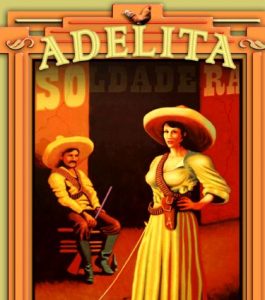This post is also available in:
 Español
Español
The commemoration of the “Cinco de Mayo” and its “Batalla de Puebla (Battle of Puebla) reminds us of the how a ranchera song like “La Adelita” tells the story of the Mexican Revolution.
But before I tell you of how and why the popular ranchera “La Adelita” is a good example of songs that tell the story of the Mexican Revolution, let’s put things in perspective.
The Battle of Puebla and “La Adelita” Timelines
The Battle of Puebla occurred on the “Cinco de Mayo” (May 5th) of 1862. Ranchera music realistically came later, towards the early 20th century. It came to form when the Mexican Revolution was taking place around the events of 1910. Nevertheless, the warfare similarities are evident. The story of “Adelita” could well have happened during any war. It’s a story that could have happened during the Mexican Revolution circa 1910, the “Cinco de Mayo” Battle of Puebla on 1862, or even as far back as the Mexican Independence War circa 1810.
“La Adelita” tells the story of a woman that follows The Sergeant into battle because she’s in love with him. She is brave and beautiful. Additionally, she was the kind of woman that would ride with her Sergeant in the train or horse with a rifle or pistol ready, and serving the troops. But “Adelita” had the respect of the entire battalion, starting with the Sergeant, who would sing…
“If Adelita were to leave with another man, I would follow her over land and sea…over the sea by warship, over land in a military train. And if I die in battle, and they are going to bury my body, Adelita, in God’s name, I pray that you will cry for me.” Believe me when I say that this sounds much better in Spanish!
Video of “La Adelita“
In the video below, “La Adelita” is performed by the late popular “nueva trova” Mexican singer Amparo Ochoa. The images of the video portray scenes from the Mexican Revolution. They try to represent the main theme of the song.
Nobody is sure if the “ranchera” “Adelita” was based on a real woman or not. One thing that we do know is that “Adelita” was not the only folk hero woman portrayed in “ranchera” music. “La Valentine” and “Marietta” are two other women that also played a part of the Mexican Revolution folk legend through “ranchera” songs.
Where did “Ranchera” music come from?
“Rancheras” started in around the time of the Mexican Revolution. They where normally sang by a single person with a guitar. Like so many other Latin music genres that originated around this time, it served to tell stories to a population that mostly couldn’t read. Music became their main mean of mass communication, like a verbal newspaper.

Traditional “ranchera” themes were around love, patrotism, and nature. Later on they became associated with Mariachi bands. Taking from rural traditional folk music, “ranchera” music developed as a symbol of a new national consciousness in reaction to the aristocratic tastes of the period.
Some of the most popular exponents of “ranchera” music are Antonio Aguilar, Flor Silvestre, Amalia Mendoza, Lucha Villa, Cuco Sanchez, Rocío Dúrcal, José Alfredo Jiménez, Lola Beltrán, Vicente Fernández, Pedro Infante, Jorge Negrete, and Javier Solís.
The roots of the word “ranchera” come from the word “rancho”. This is because the songs originated on the ranches and in the countryside of rural Mexico. The “ranchera” is also performed by “norteño” or “banda” groups of northern Mexico or southern U.S..
My favorite “ranchera” composer was the late Jose Alfredo Jimenez. He probably owns the biggest songbook in this genre even today. Additionally, I also like the popular contemporary Mexican singer-songwriter Juan Gabriel.
The commemoration of the “Cinco de Mayo” and the Battle of Puebla remind us of that time in Mexican history. “La Adelita” is a classic that cannot be chronologically associated with the “Cinco de Mayo”. However, it can certainly illustrate the role brave Mexican women had in Mexican history.
Cover art: by Aida Emart


Looking for a story and song i heard on the radio a few days ago. I don’t really understand alot of spanish but I’m trying to learn. From what i heard . It was about the revolution and it was part song and part storytelling. Can someone tell me who are the artists?
[…] reason Ranchera themes are mostly about patriotism and love. A good example is the ranchera “Adelita“, which touches on both […]
[…] recordings of 1907 to 1909 preceded the 1910 Mexican Revolution that ended the dictatorship period known as the […]
[…] However, I also write about Boleros, Latin Pop, Latin Rock, Reggaetón, Vallenato, Merengue, Tango, Ranchera, Trova, and just about any music from Latin America. (Note: check the […]